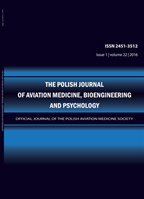2013, Volume 19, Issue 1
Comparison of the Results of ATL and Respiratory Parameters Before and After the Anti-G Training
Mieczysław WOJTKOWIAK1, Marcin BIERNACKI2
-------------------------------------------------------------------------------------------------
1Department of Physiology, Military Institute of Aviaton Medicine
2Department of Psychology, Military Institute of Aviaton Medicine
Full text
Streszczenie
Introduction. The analysis of Acceleration Tolerance Limit (ATL), carried out in previous years during tests in a human centrifuge, showed a sustained reduction in this index, which was associated with a decrease in the intensity of targeted physical exercises preventing the occurrence of back pain. Methods. The obtained results were compared with the results recorded after the physical training - Anti-G Straining Maneuver (AGSM) - in the Polish Military Conditioning Training Center (PL:WOSzK). The study on sustaining ATL over the years included 11 pilots prepared to fly MIG-29. The study subjects who made the reference material were the same pilots who took part in the first training conducted in the training center 3-4 years earlier. In addition to the standard Gradual Onset Rate (GOR) tests performed in the human centrifuge, special attention was paid to the measurements of respiratory parameters, the differences in which could significantly affect the performance of the L-1 maneuver, namely: lung vital capacity, time of apnea holding, maximum pressure of air expiration against the closed glottis, and the Flack's Test. Results: Following the training, special breathing indices showed statistically significant differences. They were associated with the use of the training program focusing on AGSM increase. The program was introduced in the WOSzK to the annually conducted training programs for jet pilots. The comparative analysis of the ATL results in pilots after some years since the training in WOSzK with the results obtained before and after the training showed a slight decrease in this index, which-according to the +Gz tolerance scale - ranged within good limits. Discussion. The comparative analysis of the ATL results obtained before the training and some years after it showed a statistically significant decrease. As shown by the surveys conducted among the analyzed group of pilots, flight dynamics load was lower compared to the examination performed after a period of 3-4 years. Conclusions. The exercises introduced in the WOSzK which aimed to increase AGSM influenced significantly the level of ATL and selected respiratory parameters. It can be assumed that the value of ATL may be affected by the dynamics of flights with acceleration and performing AGSM exercises from time to time. It is believed that the results obtained after some years were associated with performing frequent flights under +Gz acceleration and with the sustained training effects related to the L-1 maneuver. Corrections in performing the L-1 maneuver introduced by some pilots can, over time, during subsequent maneuvers under +Gz acceleration, cause early fatigue, reduced response speed, and decreased effectiveness of the physiological mechanisms of system compensation and ATL.
Słowa kluczowe
+Gz acceleration, ATL after some years, AGSM training
